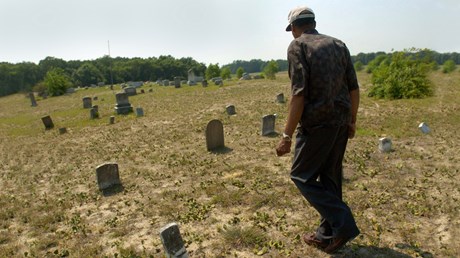African American church graveyards are disappearing. Can they be saved before it’s too late?

They needed a John Deere Gator to reach the perimeter. Then, in the forested area behind a power plant in Williamsburg, Virginia, Colette Roots and her small expedition had to jump over ditches full of rainwater, where they could see tadpoles and mosquito eggs. They went in.
The plot of land belonged to a Black congregation in the 1940s. The historic church, Oak Grove Baptist, is still active. Roots grew up in the congregation, and as a child, she helped her mother maintain the graves at the church’s main cemetery—a much larger plot roughly a mile from this one, with about 150 graves.
The church lost access to this smaller graveyard decades ago, thanks in part to a massive land seizure by the federal government. By the summer of 2021, most everyone who knew the exact whereabouts of the Christians buried back here had died themselves.
Hidden away like this, in the trees and brush, the graves remind Roots of the Sunday school song about hiding your light under a bushel. When she saw them that day, she had the same reaction: No.
There were a dozen markers, some lying flat and others standing upright. The inscriptions showed that most of the deceased were children, and at least three were related to Roots by marriage. For a moment she was overcome with grief.
The dead needed to be taken care of. They belonged with the other deceased saints at the main burial grounds.
Everyone at Oak Grove agreed with her. But this left them with a conundrum. With an aging congregation, just a fraction of its former size, Oak Grove Baptist has enough trouble paying its utility bills. Relocating a cemetery is not in its budget.
The congregation’s dilemma is not unusual for Black churches. Recently, 26 potential graves were identified ...
from Christianity Today Magazine
Umn ministry


.gif)

.gif)
.gif)
